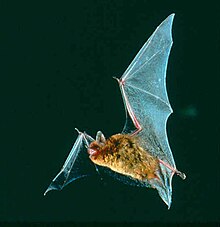Southeastern myotis
The southeastern myotis (Myotis austroriparius) is a small species of bat. It found throughout the Gulf Coastal Plain and the Lower Mississippi alluvial plain of the southeastern United States.
| Southeastern myotis | |
|---|---|

| |
| Scientific classification | |
| Domain: | Eukaryota |
| Kingdom: | Animalia |
| Phylum: | Chordata |
| Class: | Mammalia |
| Order: | Chiroptera |
| Family: | Vespertilionidae |
| Genus: | Myotis |
| Species: | M. austroriparius
|
| Binomial name | |
| Myotis austroriparius (Rhoads, 1897)
| |

| |
| Distribution of the southeastern bat (1989) | |
Description
changeThe southeastern myotis weighs 5–8 g. It eats mainly insects. The southeastern bat, rests by day and look for food at night. The southeastern bat has a wingspan of about 9-11 inches. Pelage varies from gray to bright orange-brown. The females are generally more brightly colored than the males.
This species is sometimes seen roosting with Rafinesque's big-eared bats.[2]
Distribution and Habitat
changeThe range of this species includes southern Illinois and Indiana in the north, westward into southeastern Oklahoma, western Tennessee and Arkansas, and northeastern Texas, and eastward to the southern part of North Carolina.[3]
The southeastern myotis lives in bottomland hardwood forests. It roosts and looks for food near water. Bottomland hardwood forests usually contain bald cypress and water tupelo which are common roosting trees of bottomland bats. Good habitats are made up of trees of sufficient size and maturity sufficient for tree cavities to form.[4] They are also known to roost in caves, cisterns, abandoned buildings, and under bridges.[5]
Ecology
changeSoutheastern myotis are an important source of food for barred owls, particularly in the nesting season.[6] They are less important as a source of food outside of the nesting season.[6]
References
change- ↑ Arroyo-Cabrales, J. & Ticul Alvarez Castaneda, S. (2008). "Myotis austroriparius". IUCN Red List of Threatened Species. 2008. Retrieved 7 February 2010.
- ↑ "Archived copy" (PDF). Archived from the original (PDF) on 2015-09-23. Retrieved 2021-02-08.
{{cite web}}: CS1 maint: archived copy as title (link) - ↑ Whitaker, J., W. Hamilton. 1998. Mammals of the Eastern United States. Ithaca, New York: Cornell University Press.
- ↑ Medlin, Rex E.; Risch, Thomas S. (2008). "Habitat Associations of Bottomland Bats, With Focus on Rafinesque's Big-Eared Bat and Southeastern Myotis". The American Midland Naturalist. 160 (2): 400–412. doi:10.1674/0003-0031(2008)160[400:HAOBBW]2.0.CO;2. S2CID 86232249.
- ↑ Carver, Brian D.; Ashley, Nolan (2008). "Roost Tree Use by Sympatric Rafinesque's Big-Eared Bats (Corynorhinus Rafinesquii) and Southeastern Myotis (Myotis Austroriparius)". The American Midland Naturalist. 160 (2): 364–373. doi:10.1674/0003-0031(2008)160[364:RTUBSR]2.0.CO;2. S2CID 86319803.
- ↑ 6.0 6.1 Bergstrom, B. J., & Smith, M. T. (2017). Bats as Predominant Food Items of Nesting Barred Owls. Southeastern Naturalist, 16(1), N1-N4.
